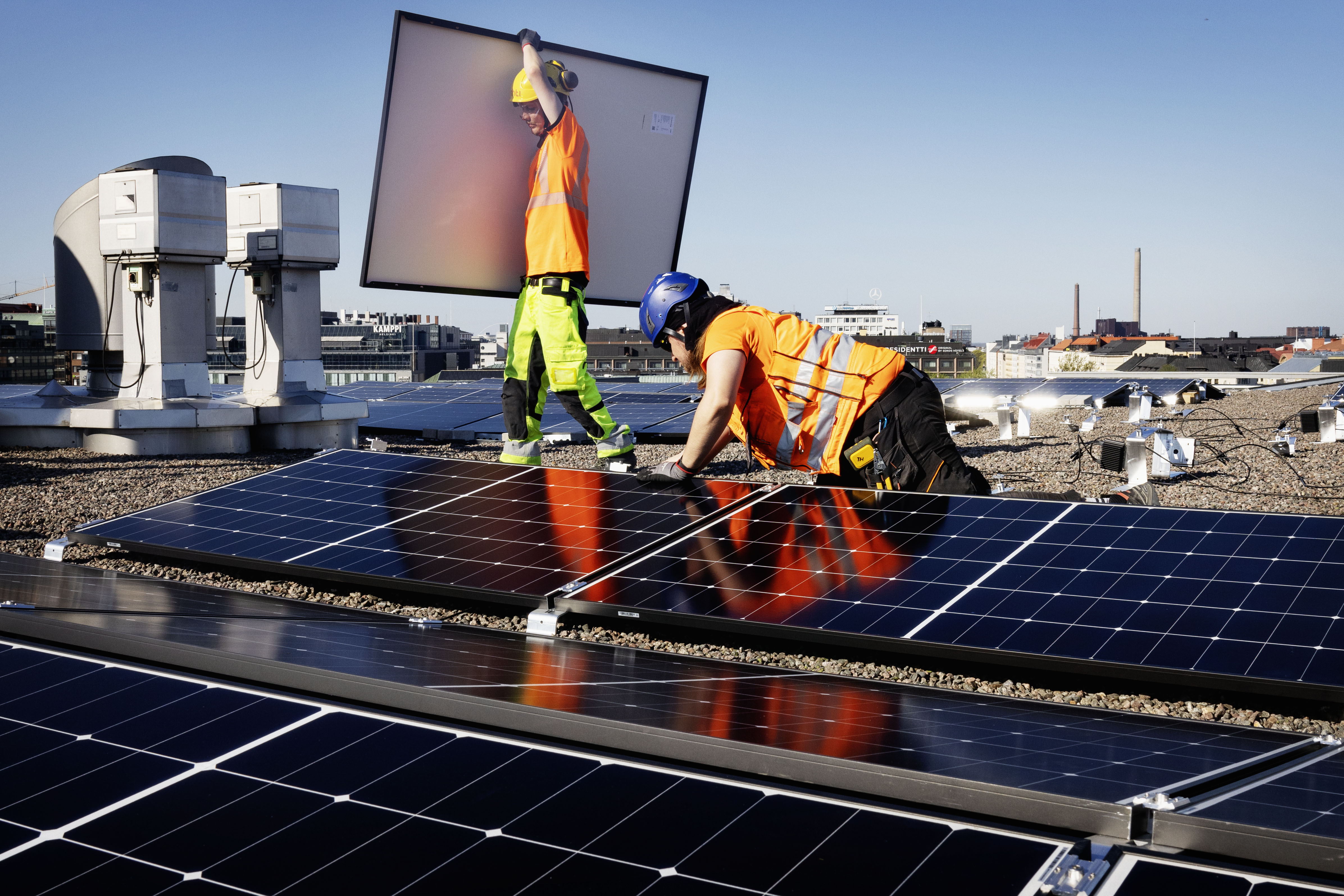 Solar power company Solnet's employees Joonatan Korkeavuori (left) and Tuomas Heikkinen (right) installing solar panels on the roof of the Sanoma House in May 2024. Photo: Kaisa Rautaheimo / HS
Solar power company Solnet's employees Joonatan Korkeavuori (left) and Tuomas Heikkinen (right) installing solar panels on the roof of the Sanoma House in May 2024. Photo: Kaisa Rautaheimo / HS
Sanoma has commissioned a solar power plant in Helsinki and Tampere. The solar power plant at the Sanoma House in Helsinki started up in early June and the Manu printing house in Tampere will be equipped with solar power in July.
Even before the solar power plants were installed, Sanoma had already been using fossil-free electricity in its operations and switched to renewable district heating. The use of solar power strengthens renewable electricity production, energy independence and also generates cost savings.
Sanoma House is equipped with 320 solar panels which, in the future, will cover four per cent of the building’s gross electricity consumption. The panels have a peak output of 136 kilowatts. The annual output of the solar power plant is 123 megawatt-hours, equivalent to the annual consumption of about ten electrically heated detached houses.
Sanoma House was built 25 years ago, and it is located in central Helsinki. In recent years, the building’s energy efficiency has been improved, for example through energy efficiency renovation and artificial intelligence. Sanoma House is environmentally certified by BREEAM (Building Research Establishment Environmental Assessment Method) certification. The building’s owner, German real estate investment company Deka, ordered the solar panels from Solnet Oy. Sanoma is a tenant in the investment and the power plant's electricity will be available to Sanoma free of charge until the end of the lease period.
During the summer, solar power will also be introduced at the Manu printing house in Tampere, where 1,805 solar panels will be installed on the roof.
Solar power can cover up to seven per cent of gross energy production. The panels’ peak output is 489 kilowatts and the solar plant’s produces 566 megawatt-hours per year, which equals the annual energy consumption of approximately 47 electrically heated detached houses. Solnet Oy will also be in charge of installing the panels at the Manu printing house, as commissioned by the building’s owner LähiTapiola. At Manu, Sanoma buys sustainably generated electricity at a fixed price.
At the Sanomala and Manu printing houses, environmental management is implemented through the ISO 14001 system.
“In the bigger picture, the amount of energy produced with solar panels is small, but an important part of making our climate work concrete. We are not doing this just to become compliant in some way, but to actually walk the talk and be the example our clients expect us to be. Our staff are also proud of this concrete climate work”, says Timo Tassi, Operations Director of production and logistics at Sanoma.
Tassi is a member of Sanoma Media Finland’s environmental working group which seeks to promote Sanoma’s climate and environment goals. The working groups consists of representatives from Sanoma’s printing houses, procurement, property management, logistics, production and sustainability.
“We established our working group four years ago to enable smooth, low-threshold development work among those who make decisions on climate and the environment. For example, our climate strategy requires cooperation from many different functions in order to reach our goals and to have one, shared direction. We have already accomplished remarkable things. For example, our own-use emissions related to energy consumption at our premises and company cars have fallen by 31 per cent and supply chain emissions by 29 per cent between 2021 and 2023”, says Eveliina Nygren, Sanoma’s Sustainability Manager.
The international Science Based Targets initiative (SBTi) has approved Sanoma’s near-term science-based emission reduction targets for own operations (Scope 1 and 2) and value chain (Scope 3). Sanoma has committed to reduce greenhouse gas emissions from its own operations by 42% and greenhouse gas emissions in the value chain from purchased products and services, indirect emissions from purchased energy and transport by 38% by 2030 compared to the baseline year 2021.
Read more in Finnish:
